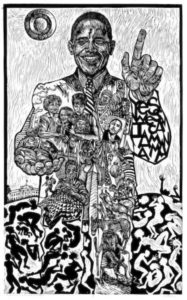Still unfamiliar with every aspect of the buildings on our campus, I did not know that we had an art gallery in Brodie Hall until my class attended a lecture by the art gallery director, Cynthia Hawkins-Owen. Walking into the room, I instantly saw Steve Prince’s name in bold letters and large pieces of his artwork on the walls. Sitting in the room, I was mesmerized. Here are more compositions to unpack that I did not know existed. Hawkins-Owen described the process of an art director and the troubles she faces. One that stood out to me while she was talking was how sometimes with art we do not get all sides of the story. Every piece tells its own narrative and it’s the artist’s job to depict a certain message to the viewers.
After Hawkins-Owen walked us through the process of establishing an exhibition, we were allowed to view the compositions on the walls. At first, I just looked at a piece and walked away. But then, I remembered how Dan DeZarn mentioned that the average time a person looks at a piece of artwork is 15-30 seconds. Therefore, I corrected myself. Instead of walking around and aimlessly admiring the art pieces like I used to, I took time to analyze and reflect on the artworks.

A Jazz Song with a Lot of Blue Notes By Steve Prince
The one that I took time with was A Jazz Song with a Lot of Blue Notes by Prince, pictured above. What made me gravitate towards it was the detail surrounding and encompassing President Obama. First, I noticed his tie and how it represents America. But, I noticed something interesting right away. Using DeZarn’s advice to try and find triangles in compositions, I noticed towards the left-hand side of the art piece representation of the Ku Klux Klan. They are in a bag underneath people that Obama carries. This part puzzled me. Why would Prince incorporate them with the image of Obama? Then following the movement, I noticed the words “Yes We Can”–Obama’s campaign slogan. Following down the line of movement I noticed the symbol of the cross amongst people propelling downwards. Then, once I arrived at the bottom of the composition, I stopped. There, I perceived a person being whipped in a form of fatigue and starvation. Then, I noticed the contrasting colors of white and black on both sides.
What puzzles me the most about this art piece is the title. I interpreted that the “Blue Notes” represented democracy or the democratic party because that is the color they are associated with. But, why “A Jazz Song?” After I looked at the title I discussed this with Corinne and we were puzzled. I knew it had to relate back to New Orleans because that is where music, especially Jazz, thrives. But, why relate it to America? And why with Obama?
Upon further reflection, I now realized that Prince incorporated many different sides of the story. Just as Hawkins-Owen had said in the beginning, art depicts sides of the story. Prince decided to depict the good side of America and the negative side with the Ku Klux Klan and the starvation in the world. This brought me back to the Kinetic project where SUNY Geneseo students had to depict all the negative aspects of life and the hopeful side. But, the question still remains: why that specific title?
Then, it hit me! In the anthology Walking Raddy: The Baby Dolls of New Orleans, it mentions how jazz can be dissonant with sound from the West African culture (172). According to Google, the word “dissonance” has two definitions: 1) lack of harmony among musical notes, such as cacophony; 2) a tension or clash resulting from the combination of two disharmonious or unsuitable elements. Jazz is known for having dissonance as a prominent feature within songs. I believe Prince titled his composition A Jazz Song with a Lot of Blue Notes both to acknowledge the jazz musical component of dissonance, and to allude to America creating its own dissonance or “two disharmonious or unsuitable elements.” With the incorporation of the negative and the positive of American society, Prince highlights that America is currently creating a disharmonious society. Therefore, the title signals that America is currently forming a dissonant, chaotic, unsettling song. Similar to jazz, American society conflicts within itself, unable to resolve.
